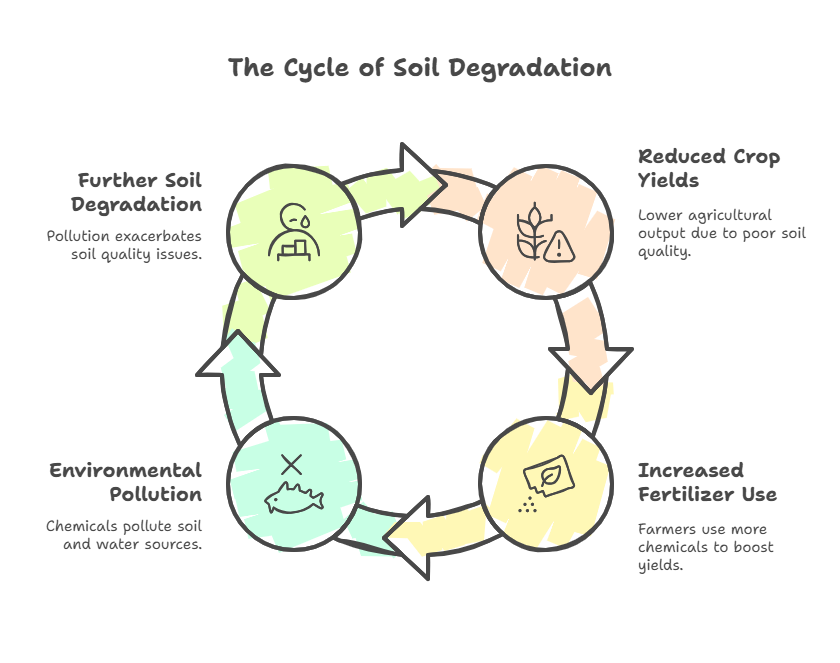- Filter By :
- Geography
- History
- Indian Heritage & Culture
- Indian Society
-
Q. How do regional variations in soil types across India influence patterns of cropping intensity and land degradation? (250 words)
14 Jul, 2025 GS Paper 1 GeographyApproach:
- Introduce the answer by briefing about soils in India and regional vulnerability
- Give Regional Soil Types and Their Impact on Cropping Intensity
- Highlight Impact of Soil Degradation on Agriculture
- Delve into Sustainable Agriculture Practices to Combat Degradation
- Conclude suitably.
Introduction:
India’s vast and diverse geographical expanse gives rise to a variety of soil types, each with its unique characteristics. The regional variations in soil composition, texture, and fertility significantly influence agricultural practices, cropping intensity, and patterns of land degradation.
- With regions like Punjab facing soil depletion due to intensive farming, and states like Rajasthan battling desertification, the country's soil challenges are region-specific.
Body
Regional Soil Types and Their Impact on Cropping Intensity:
- Alluvial Soils: Found predominantly in the Indo-Gangetic plains, these soils are fertile and support high-intensity cropping.
- The rich nutrient content allows for multiple cropping cycles per year, especially in states like Punjab, Haryana, and Uttar Pradesh.
- Wheat, rice, and sugarcane are common crops. However, over-cropping in these regions can lead to nutrient depletion, making crop rotation necessary for sustainability.
- Black Soils: Found mainly in Maharashtra, Madhya Pradesh, and parts of Gujarat and Tamil Nadu, black soils (regur soils) are rich in minerals like lime, iron, and magnesium, making them ideal for cotton cultivation.
- These soils support moderate cropping intensity but are prone to waterlogging during excessive irrigation, affecting crop yields.
- Red Soils: Red soils, common in southern India (Tamil Nadu, Karnataka, Andhra Pradesh), are low in nitrogen, phosphorus, and organic matter, leading to lower cropping intensity.
- Crops such as groundnut, cotton, and pulses are more common in these regions, but poor fertility often limits the number of crops grown annually.
- Desert Soils: Found in the arid and semi-arid regions like Rajasthan, desert soils are low in nutrients and moisture.
- Cropping intensity is relatively low, with only drought-resistant crops like millet and pulses being cultivated.
- These regions face challenges of water scarcity, limiting cropping patterns and making agriculture highly dependent on irrigation.
- Laterite Soils: Found in the western and eastern coastal regions, particularly in Kerala, Karnataka, and Goa, these soils are rich in iron and aluminium but poor in essential nutrients like nitrogen and phosphorus.
- This makes the region's cropping intensity lower, with crops like cashew, rubber, and tea being predominant.
Impact of Soil Degradation on Agriculture:
- Erosion and Desertification: The topography and soil composition in regions like Rajasthan, parts of Maharashtra, and Madhya Pradesh make them highly prone to soil erosion and desertification, especially when agricultural practices like overgrazing, deforestation, and monocropping are not properly managed.
- Soil erosion strips the land of fertile topsoil, reducing agricultural productivity.
- Salinization and Waterlogging: In regions where irrigation is intensive, such as in the Indo-Gangetic plains, excessive use of water leads to waterlogging and salinization of soils. This makes the land less productive, reducing the cropping intensity.
- The rise of salts in the soil not only degrades its structure but also makes it unsuitable for many crops.
- Areas in Uttar Pradesh face these challenges, reducing long-term agricultural viability.
- Loss of Soil Fertility: Continuous monocropping, especially in areas with fertile alluvial soils, depletes essential nutrients, leading to soil exhaustion.
- This is seen in the high-intensity cropping zones of Punjab and Haryana. Overuse of chemical fertilizers to compensate for the loss of natural fertility leads to soil health deterioration over time.
- Acidification: Some regions, particularly those with laterite soils in Kerala and parts of Tamil Nadu, are vulnerable to soil acidification due to the excessive use of chemical fertilizers.
- This reduces the soil's ability to retain nutrients, thus affecting crop yields and agricultural sustainability.
Sustainable Agriculture Practices to Combat Degradation:
- Crop Rotation and Diversification: Encouraging crop rotation and diversified cropping systems can help restore soil fertility and reduce the risk of soil exhaustion.
- In regions with black and alluvial soils, alternating cereals with legumes and pulses can improve soil health.
- Water Conservation Techniques: In water-scarce regions, like those with desert soils, the adoption of rainwater harvesting, drip irrigation, and other water-efficient farming practices can mitigate the impact of waterlogging and salinization.
- Organic Farming: Using organic fertilizers, mulching, and reducing the use of chemical pesticides and fertilizers can help maintain soil health, especially in areas with red and laterite soils, where natural fertility is low.
- Agroforestry and Soil Conservation: In regions prone to erosion, such as the western ghats and parts of the Himalayas, agroforestry and soil conservation practices (like contour plowing and terracing) can help prevent further degradation and maintain soil structure.
Conclusion:
Regional variations in soil types across India have a profound impact on cropping intensity and land degradation. As Mahatma Gandhi rightly said, "The earth provides enough to satisfy every man's need, but not every man's greed." Sustainable management of soil resources is essential to meet the growing demands of agriculture while protecting the environment and progressing towards Land Degradation Neutrality by 2030.
To get PDF version, Please click on "Print PDF" button.
Print PDF





